skip to main |
skip to sidebar
I may have mentioned once or twice or a few dozen times that, or the first 30 or so years of my life, I hated parakkai (also known as pavakkai, karela, bittermelon or bittergourd - or, if you're my husband, as "green rats"). If you're a karela lover, today's recipe will be right up your street. If you're not a karela lover, this recipe will still be quite a way up your street because you will not taste the bitterness from the vegetable at all.
If you know your karela at all, you would think it's hard to mask the bitterness, but because everything is roasted and there are lots of other ingredients, the resultant powder has no discernible bitterness. At least, none that I could taste. And I didn't even peel the skin or discard the seeds (although if they're red and hard, DO scoop them out and discard) or salt the cut bittergourd to reduce the bitterness. Because I'm lazy and that's the way I roll, baby.
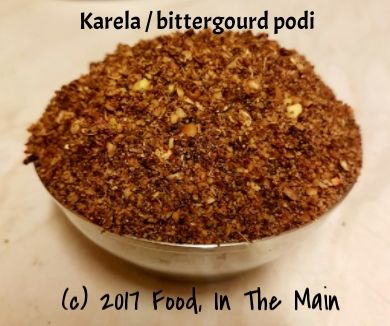
I ate this mixed with rice and ghee, I ate it sprinkled over roasted vegetables, I ate it as a side with kootu and roti, I ate it mixed with yogurt both as a dip and as a salad dressing - it's my most favourite thing at the moment, and it seems to work with everything.
Best of all, since the karela is oven roasted with only a mimimal amount of oil, it's a healthy podi. There are versions where the vegetable is deep fried until crisp, but - while I love deep fried foods with a deep and abiding love - I see no need to load this podi with unnecessary calories.
Recipe for: Bittergourd / pavakkai / karela podi
Ingredients:

3-4 medium size tender karela
10 dried red Kashmiri chillies
2 tbsp coriander seeds
2 tbsp whole urad dal
2 tbsp chana dal
2 tbsp kollu or horsegram
2 tbsp fresh or frozen grated unsweetened coconut
1 tbsp black sesame seeds (regular will probably also do)
Handful of curry leaves (fresh or frozen)
2-3 cloves of garlic, halved
1 small gooseberry sized ball of tamarind (seeds and strings removed if any)
1/2 tsp asafoetida powder
1/2 tsp + 1 tbsp oil
Salt to taste (or about 1.5 tsp)
Method:
1. Thinly slice the karela, mix with 1 tbsp oil and roast in a 180C/350F oven until the slices are brown with very little green showing. This should take about 30 minutes, but be sure to stir them around every 10 minutes so that they crisp evenly. Let them cool completely.
2. Heat the oil in a wok and add the red chillies. Roast on a medium-low flame, stirring often until the chillies turn a darker shade, about 5 minutes. Be careful not to burn them or you'll regret the fumes! Remove to a plate and cool.
3. Add the coriander seeds, the sesame seeds and all the dals. Dry roast them, stirring often, until they are toasted and fragrant, and turn a darker shade. Again, don't burn them or the podi will taste bitter. Add to the roasted chillies and let cool.
4. Finally, add the coconut, curry leaves, garlic and tamarind and toast in the pan, stirring frequently, until the coconut has turned golden brown and has no more moisture in it - yet again, be careful not to burn it.
5. Once all the ingredients are cool, grind them into a slightly coarse powder. Add salt and asafoetida powder and mix well. Store in an airtight container.
I suppose I should be embarrassed about even considering this a recipe - and I suppose I am, a bit. But if I didn't write about it, there wouldn't be a post. There needs to be a post, and many more posts, if I am to reach my target of 500 posts. Not 500 posts this year (I wish!), but 500 posts in total since I started this blog. Looked at it that way, my output isn't particularly noteworthy, really. But it's all I have.
Anyway, I wish I could remember which blog it was where a commenter had mentioned that she always mixed raw karela with some yogurt and microwaved it for 3 minutes before going on to cook the vegetable on the hob.. and this way the karela was NEVER bitter.
I thought I’d try that out too, but I’m not sure how much it helped, if it did at all. Maybe it reduced the bitterness a little - but then I don’t have a huge problem with the bitterness of the vegetable when it’s shallow fried, especially as a side dish with rice. In any case, unless you try it cooked with yogurt and without, and compare the two side-by-side, it’s pretty hard to quantify any reduction in the level of bitterness in any useful way. Next time, maybe.
The karela rice only happened because I forgot to make sambar or any other kuzhambu, and I didn’t have any paruppu podi or thogayal ready – and only realized this when I got hungry for my dinner.
No problem – I mixed the karela dry-fry with the rice and called it “karela rice” and had that with yogurt, thereby getting around the problem of the missing sambar. Inspired innovation? Or merely good spin put on a pathetic situation? You decide.
Recipe for: Karela rice
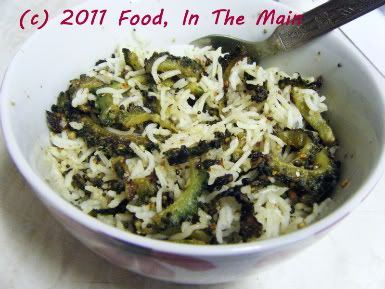 Ingredients:
1 cup basmati rice, cooked and cooled
2 medium karela (bitter melon/gourd)
2 tbsp yogurt/curd
1 tsp mustard seeds
5-6 fresh curry leaves
2 tbsp oil
Salt to taste
3 tbsp vegetable spice mix
Method:
1. Halve the karela lengthwise, then slice it into thin half-moons.
Ingredients:
1 cup basmati rice, cooked and cooled
2 medium karela (bitter melon/gourd)
2 tbsp yogurt/curd
1 tsp mustard seeds
5-6 fresh curry leaves
2 tbsp oil
Salt to taste
3 tbsp vegetable spice mix
Method:
1. Halve the karela lengthwise, then slice it into thin half-moons.
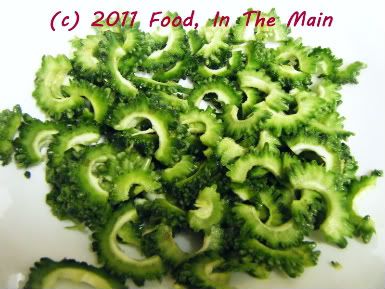 2. Toss the pieces with the yogurt/curd until they are evenly coated. Microwave, covered, for 3 minutes. Reserve.
2. Toss the pieces with the yogurt/curd until they are evenly coated. Microwave, covered, for 3 minutes. Reserve.
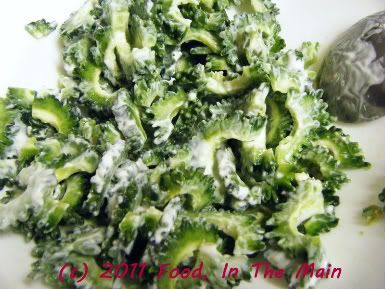 3. Heat the oil in a pan and add the curry leaves and mustard seeds. Let the seeds pop on meium-high heat, then add the karela pieces and stir well.
3. Heat the oil in a pan and add the curry leaves and mustard seeds. Let the seeds pop on meium-high heat, then add the karela pieces and stir well.
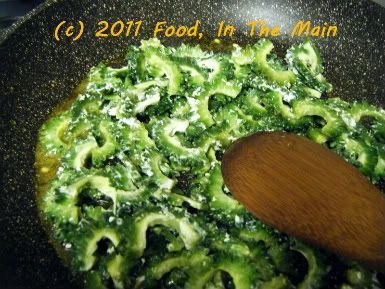 4. Let the karela cook on low heat for 8-10 minutes, till they are soft and cooked. Then turn the heat up to medium so that they can become a little crisp and brown. Add salt to taste and mix in.
5. Now add the 3 tbsp vegetable spice mix and stir well.
4. Let the karela cook on low heat for 8-10 minutes, till they are soft and cooked. Then turn the heat up to medium so that they can become a little crisp and brown. Add salt to taste and mix in.
5. Now add the 3 tbsp vegetable spice mix and stir well.
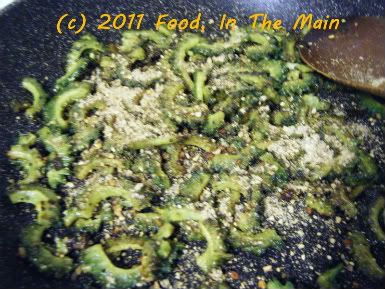 6. Now mix in the rice gently with the karela, so as not to break the grains. Turn the heat down to low and let the rice heat up thoroughly. Serve hot with raita and papad or potato chips.
RECIPE: KARELA RICE
Ingredients:
1 cup basmati rice, cooked and cooled
2 medium karela (bitter melon/gourd)
2 tbsp yogurt/curd
1 tsp mustard seeds
5-6 fresh curry leaves
2 tbsp oil
Salt to taste
3 tbsp vegetable spice mix
Method:
1. Halve the karela lengthwise, then slice it into thin half-moons.
2. Toss the pieces with the yogurt/curd until they are evenly coated. Microwave, covered, for 3 minutes. Reserve.
3. Heat the oil in a pan and add the curry leaves and mustard seeds. Let the seeds pop on meium-high heat, then add the karela pieces and stir well.
4. Let the karela cook on low heat for 8-10 minutes, till they are soft and cooked. Then turn the heat up to medium so that they can become a little crisp and brown. Add salt to taste and mix in.
5. Now add the rice to the karela along with 3 tbsp of the vegetable spice mix. Mix it in gently so as not to break the rice grains.
6. Turn the heat down to low and let the rice heat up thoroughly. Serve hot with raita and papad or potato chips.
6. Now mix in the rice gently with the karela, so as not to break the grains. Turn the heat down to low and let the rice heat up thoroughly. Serve hot with raita and papad or potato chips.
RECIPE: KARELA RICE
Ingredients:
1 cup basmati rice, cooked and cooled
2 medium karela (bitter melon/gourd)
2 tbsp yogurt/curd
1 tsp mustard seeds
5-6 fresh curry leaves
2 tbsp oil
Salt to taste
3 tbsp vegetable spice mix
Method:
1. Halve the karela lengthwise, then slice it into thin half-moons.
2. Toss the pieces with the yogurt/curd until they are evenly coated. Microwave, covered, for 3 minutes. Reserve.
3. Heat the oil in a pan and add the curry leaves and mustard seeds. Let the seeds pop on meium-high heat, then add the karela pieces and stir well.
4. Let the karela cook on low heat for 8-10 minutes, till they are soft and cooked. Then turn the heat up to medium so that they can become a little crisp and brown. Add salt to taste and mix in.
5. Now add the rice to the karela along with 3 tbsp of the vegetable spice mix. Mix it in gently so as not to break the rice grains.
6. Turn the heat down to low and let the rice heat up thoroughly. Serve hot with raita and papad or potato chips.
I find I'm a bit worried about getting more and more radical with my bitter melon/bitter gourd/karela/pavakkai recipes, in that I’m using this vegetable in a less and less disguised fashion, as it were. I won't hide the fact that I'm feeling kind of - wait for it – meloncholy, the sort that leaves a.... yes, a somewhat bitter taste behind...
Time was when the only way I would even look at this knobbly-looking vegetable was if it was coated in seasoned gram flour and deep fried. And even then it wasn’t exactly welcome on my plate (or on my palate, heh. Tell me you love these punny asides, because I won’t accept a negative answer. What, did you think this was a democratic blog? Tut).
First I made my own karela chips. Then this. And this. And now, karela masala rice! Where oh where will it all end???
Be warned, readers, this recipe is only for those who love this vegetable. (Although, all evidence to the contrary, I still maintain that I’m not a member of the aforementioned karela-loving group. I mean yeah, I eat it. But would I reach for karela over, say, potatoes? Or green beans? Or plantains? No way, no how.) I used brown basmati instead of white rice, and cooked it with a bit of turmeric powder as per Suganya’s advice on her blog, Tasty Palettes – note that the idea for this recipe, and part of the method, is derived from her own post. I added peanuts for crunch (and some relief from the bitterness) and had a cool cucumber raita on the side, which is also, I think, essential to balance the taste.
Remember that rhetorical question I asked earlier? The one I didn’t answer, because it was rhetorical? (See paragraph 3.) Well, its status has just been downgraded from rhetorical to literal, because I’m answering it.
The karela radicality, my dear friends, does not end with this post. It cannot, because there is more to come, a recipe that is even more uncompromising when it comes to bringing the bitterness to the fore. And no clue, not one, about where that radicalisation will end, or when, or even how...
But for now, here’s the recipe to go with this post.
Recipe for: Bitter melon brown rice
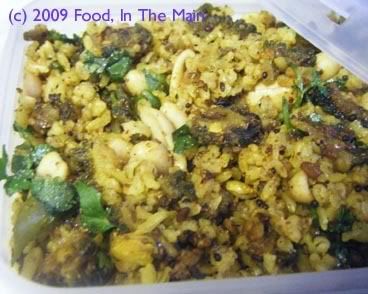
Ingredients
1-1/2 cups brown basmati rice, soaked in water for 10 minutes
3 cups bitter melon/karela, sliced
3/4 tsp tamarind paste
1/2 tsp turmeric powder
1 tsp urad dal 1 tsp brown mustard seeds
2 tsp oil
a few fresh curry leaves
3-4 tbsp garlic masala powder (or to taste)
Salt to taste
1/4 cup roasted salted peanuts
chopped coriander leaves for garnish
Method
1. Cook the soaked brown basmati rice in plenty of water to which 1 tsp turmeric powder has been added.
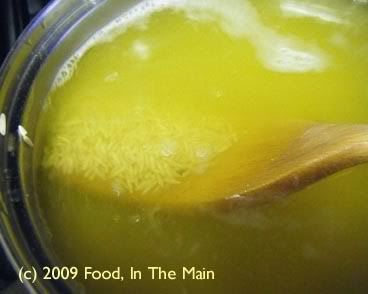
Drain rice and cool when cooked.
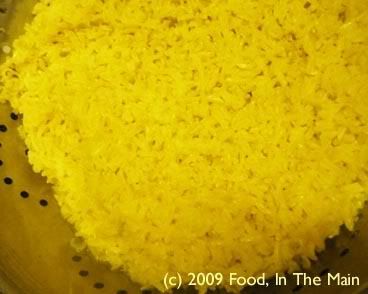
2. Dissolve the tamarind paste in 4 cups water and pour along with sliced karela in a saucepan. 
Cook the karela till done, but not mushy. Drain the cooked vegetable and reserve.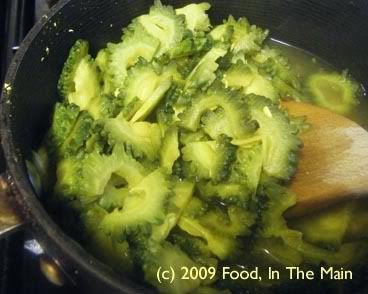
3. In a wide kadai or wok, heat the 2 tsp oil. Add the curry leaves, urad dal and mustard leaves. Cover till the mustard seeds pop, and the urad dal is golden brown. 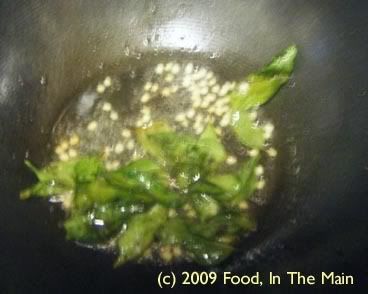
4. Add the cooked karela now and stir till the tempering is evenly distributed. 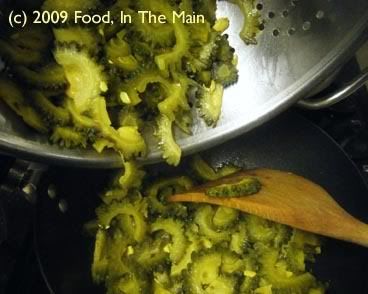
5. Sprinkle 2-3 tbsp of the garlic masala powder and stir it in. 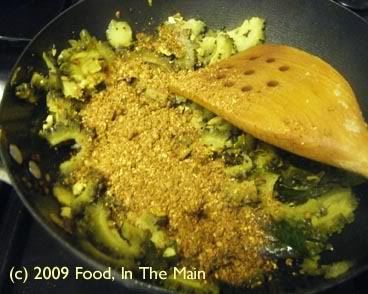
6. Roast the karela over medium heat in the pan, till it starts to crisp up. (You can add 2-3 tsp oil to speed up this process, if you like.)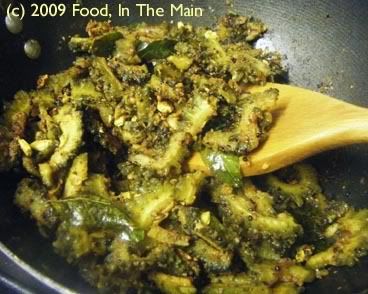
7. Add the cooked rice now, add salt to taste, and mix carefully till the vegetable is evenly distributed. 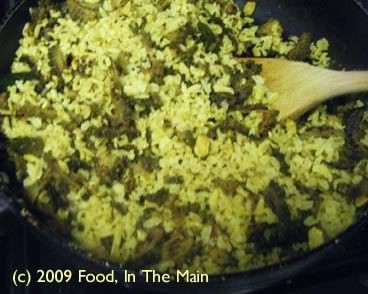
8. Stir-fry the rice till it's heated through, then add the peanuts and mix in. 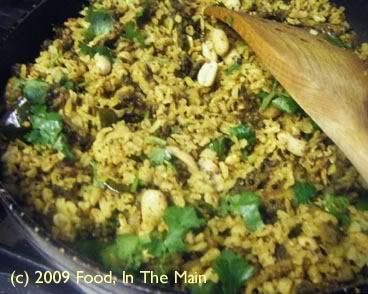 9. Sprinkle the chopped coriander over, and serve the rice hot with a cool cucumber raita and crisps or poppadums.
9. Sprinkle the chopped coriander over, and serve the rice hot with a cool cucumber raita and crisps or poppadums.
This is a recipe for grown-ups, because I cannot imagine any child ever liking something as bitter-tasting as karela or bittergourd - the name says it all. I would say that even for grown-ups, it is an acquired taste. It certainly was for me. It's only recently that I've felt like cooking karela... possibly because it's a reminder of India, and I cant get it locally - I dunno. Perhaps driving some 50-odd miles for vegetables makes me want to try even those that I'm not terribly fond of, just to justify the long trip!
I DO know that my mom hardly ever made karela at home because we kids simply would not touch it. I have to confess that even now, the only way I can eat it is if it's fried. Some of the bitterness lingers on the palate even then, but it's almost a pleasant sort of bitterness - if that can be imagined. Definitely an acquired taste.
And annoyingly, like most other unpleasant things, bittergourds are excellent for health - it's known for helping to lower blood sugar and high blood pressure, among other things. I guess the vegetable is mostly known in the Far East and India, the Caribbean and possibly parts of Africa. Bittergourds wouldnt carry off the first prize for good looks, either - the outer skin, ridged and knobbly, always reminds me of crocodile skin.
The bitterest part of the vegetable is the seeds inside. So unless the bittergourds are very young and tender, I would always recommend that the middle portion (containing the seeds) should be scraped out. Sprinkling the cut vegetable with salt and leaving it to sit for about an hour helps bring out the watery content, thereby reducing the bitterness some more.
I dont know how much of the goodness is lost in frying the bittergourd, but I figure that eating it fried will still be more beneficial than not eating it at all. Well, it makes sense to me...
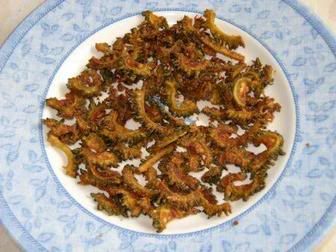
Recipe for: Karela (bittergourd) chips
Ingredients:
3-4 bittergourds
2 tsp salt
For the seasoning:
2 tbsp rice flour
2 tbsp gram flour
1 tsp red chilli powder (or more according to taste)
1 tsp coriander powder
1 tsp cumin powder
a pinch of asafoetida powder (optional)
Method:
1. Slice each piece of bittergourd into fairly thin half-moon shape. Transfer them to a colander and sprinkle the salt over. Shake the colander to distribute the salt evenly. Leave to rest for about an hour or so.
2. Squeeze out as much moisture as possible from the bittergourd pieces and dry them on paper towels. Transfer to a Ziploc bag or a big bowl.
3. Mix the seasoning ingredients together and sprinkle over the pieces. Shake the bag or bowl so that the seasoning is distributed evenly over the pieces.
4. Heat the oil in a wok, and fry the bittergourd pieces in batches to a crisp brown.
Serve as an accompaniment with Indian rice dishes, or eat as a snack.




















